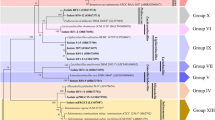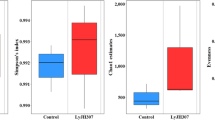Abstract
A saccharolytic spirochete that associated and interacted with cellulolytic bacteria was isolated from bovine rumen fluid. Isolation was accomplished by means of a procedure involving serial dilution of a sample of rumen fluid into a cellulose-containing agar medium. Clear zones appeared within the medium as a result of cellulose hydrolysis by rumen bacteria. The saccharolytic spirochete and a cellulolytic bacterium later identified as a strain of Bacteroides succinogenes were isolated from the clear zones. The spirochete did not utilize cellulose, but grew in coculture with the cellulolytic bacterium in cellulose-containing media. When cocultured in these media the spirochete used, as fermentable substrates, soluble sugars released from cellulose by the cellulolytic bacterium. In cellulosecontaining agar medium the spirochete enhanced cellulose breakdown by the B. succinogenes strain. Electron microscopy showed that the helical spirochete cells possessed an outer sheath, a protoplasmic cylinder, and two periplasmic fibrils. Under a CO2 atmosphere, in a reduced medium containing inorganic salts, rumen fluid, glucose, and NaHCO3, the spirochete grew to a final density of 1.9×109 cells/ml. Succinate, acetate, and formate were products of the fermentation of glucose by growing cells. CO2 (HCO3 -), branched short-chain fatty acids, folic acid, biotin, niacinamide, thiamine, pyridoxal, and a carbohydrate were required for growth of the spirochete. The results of this study indicated that the rumen spirochete represents a new species of Treponema. It is proposed that the new species be named Treponema bryantii.
Similar content being viewed by others
Abbreviations
- cpm:
-
counts per minute
- GC:
-
guanine plus cytosine
- Tm :
-
melting temperature
- PC:
-
protoplasmic cylinder
- PF:
-
pertplasmic fibrils (axial fibrils)
- OS:
-
outer sheath
- ID:
-
insertion disk
References
Akin, D. E.: Ultrastructure of rigid and lignified forage tissue degradation by a filamentous rumen microorganism. J. Bacteriol. 125, 1156–1162 (1976)
Bailey, R. W.: Quantitative studies of ruminant digestion, II. Loss of ingested plant carbohydrates from the reticulo-rumen. N. Zeal. J. Agric. 10, 15–32 (1967)
Breznak, J. A., Canale-Parola, E.: Morphology and physiology of Spirochaeta aurantia strains isolated from aquatic habitats. Arch. Microbiol. 105, 1–12 (1975)
Bryant, M. P.: The isolation and characteristics of a spirochete from the bovine rumen. J. Bacteriol. 64, 325–335 (1952)
Canale-Parola, E.: Isolation, growth, and maintenance of anaerobic free-living spirochetes. In: Methods in microbiology, Vol. 8 (J. R. Norris, D. W. Ribbons, eds.), pp. 61–73. London, New York: Academic Press 1973
Canale-Parola, E.: Physiology and evolution of spirochetes. Bacteriol. Rev. 41, 181–204 (1977)
Canale-Parola, E.: Motility and chemotaxis of spirochetes. Ann. Rev. Microbiol. 32, 69–99 (1978)
Corin, R. E.: Peroxide degradation in Leptospira. Ph. D. Thesis, University of Massachusetts (1979)
Cwyk, W. M., Canale-Parola, E.: Treponema succinifaciens sp. nov., an anaerobic spirochete from the swine intestine. Arch. Microbiol. 122, 231–239 (1979)
Dehority, B. A.: Carbon dioxide requirement of various species of rumen bacteria. J. Bacteriol. 105, 70–76 (1971)
DeLey, J.: Re-examination of the association between melting point, buoyant density, and chemical base composition of deoxyribonucleic acid. J. Bacteriol. 101, 738–754 (1970)
Dinsdale, D., Morris, E. J., Bacon, J. S. D.: Electron microscopy of the microbial populations present and their modes of attack on various cellulosic substrates undergoing digestion in the sheep rumen. Appl. Environ. Microbiol. 36, 160–168 (1978)
Hespell, R. B., Canale-Parola, E.: Amino acid and glucose fermentation by Treponema denticola. Arch. Mikrobiol. 78, 234–251 (1971)
Holdeman, L. V., Moore, W. E. C.: Bacteroides. In: Bergey's manual of determinative bacteriology, 8th ed. (R. E. Buchanan, N. E. Gibbons, eds.), pp. 385–404. Baltimore: Williams and Wilkins 1974
Hungate, R. E.: Polysaccharide storage and growth efficiency in Ruminococcus albus. J. Bacteriol. 86, 848–854 (1963)
Hungate, R. E.: The rumen and its microbes. New York, London: Academic Press 1966
Hungate, R. E.: A roll tube method for cultivation of strict anaerobes. In: Methods in microbiology, Vol. 3B (J. R. Norris, D. W. Ribbons, eds.), pp. 117–132. New York, London: Academic Press 1969
Hungate, R. E.: The rumen microbial ecosystem. Ann. Rev. Ecolog. System. 6, 39–66 (1975)
Mountfort, D. O., Roberton, A. M.: Origins of fermentation products formed during growth of Bacteroides ruminicola on glucose. J. Gen. Microbiol. 106, 353–360 (1978)
Neish, A. C.: Analytical methods for bacterial fermentations, 2nd revision. National Research Council of Canada, Report No. 46-8-3, Saskatoon 1952
Scheifinger, C. C., Wolin, M. J.: Propionate formation from cellulose and soluble sugars by combined cultures of Bacteroides succinogenes and Selenomonas ruminantium. Appl. Microbiol. 26, 789–795 (1973)
Smibert, R. M.: Treponema. In: Bergey's manual of determinative bacteriology, 8th ed. (R. E. Buchanan, N. E. Gibbons, eds.), pp. 175–184. Saltimore: Williams and Wilkins 1974
Socransky, S. S., Sasaki, S., To, L.: “Piggyback” hypothesis of subgingival colonization of non-motile organisms. II. Migration in or on agar. Abst. Int. Assoc. Dent. Res., no. 969. J. Dent. Res. 57 (A), 317 (1978)
Stanton, T. B., Canale-Parola, E.: Physiology of a rumen spirochete that interacts with cellulolytic bacteria. Abst. Ann. Mtg. Am. Soc. Microbiol. I. 124, p. 101 (1978)
Stanton, T. B., Canale-Parola, E.: Enumeration and selective isolation of rumen spirochetes. Appl. Environ. Microbiol. 38, 965–973 (1979)
Wegner, E.: The metabolic fate of fatty acids required by certain rumen bacteria. Ph. D. Thesis, University of Wisconsin (1962)
Ziolecki, A., Tomerska, H., Wojciechowicz, M.: Characteristics of pure culture of Borrelia sp. isolated from the bovine rumen. Acta Microbiol. Polon. Ser. B. 7, 45–50 (1975)
Ziolecki, A.: Isolation and characterization of large treponemes from the bovine rumen. Appl. Environ. Microbiol. 37, 131–135 (1979)
Author information
Authors and Affiliations
Rights and permissions
About this article
Cite this article
Stanton, T.B., Canale-Parola, E. Treponema bryantii sp. nov., a rumen spirochete that interacts with cellulolytic bacteria. Arch. Microbiol. 127, 145–156 (1980). https://doi.org/10.1007/BF00428018
Received:
Issue Date:
DOI: https://doi.org/10.1007/BF00428018




